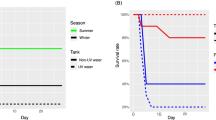Abstract
The skin fluke Neobenedenia girellae has become a serious problem in Japan since the 1990s. Present control methods focus on the removal of the attached parasite and these post-infection treatments are often labor intensive, time consuming, and/or stressful to fish. Chub mackerel Scomber japonicus are highly susceptible to N. girellae. However, because of their sensitive nature, bath treatments may cause mortality. In this study, we investigated the efficacy of cage shading to reduce skin fluke infection and the frequency of conventional post-infection treatments. Juvenile mackerel were reared in cages with or without shade for 3 months and their skin fluke infections were monitored. We performed either freshwater baths or oral administration of praziquantel if fluke intensity exceeded the given criteria. In unshaded cages, 3 total bath treatments or 6 total drug treatments were conducted. In contrast, no treatment was required for the shaded cage. The overall fluke intensity in the shaded cage was less than half that of the unshaded cages, despite the lack of treatments. This study demonstrated for the first time the practical use of shading in fish farms to reduce skin fluke infection.





Similar content being viewed by others
References
Ogawa K, Yokoyama H (1998) Parasitic diseases of cultured marine fish in Japan. Fish Pathol 33:303–309
Ogawa K (2004) Skin fluke diseases. In: Wakabayashi H, Muroga K (eds) Infectious and parasitic diseases of fish and shellfish (in Japanese). Koseisya-Koseikaku, Tokyo, pp 360–365
Harada T (1966) Studies on propagation of yellowtail (Seriola quinqueradiata T. & S.): with special reference to relationship between feeding and growth of fish reard in floating net craw. Bull Fish Lab Kinki Univ 1:1–275
Ogawa K, Bondad-Reantaso MG, Fukudome M, Wakabayashi H (1995) Neobenedenia girellae (Hargis, 1955) Yamaguti, 1963 (Monogenea: capsalidae) from cultured marine fishes of Japan. J Parasit 81:223–227
Habu K, Kuriyama I, Tanaka S (2009) Influence of immersion into fresh and low salinity waters on survival of young sevenband grouper Epinephelus septemfasciatus and removal of monogenean parasites Benedenia epinepheli and Neobenedenia girellae (in Japanese). Bull Mie Pref Fish Res Inst 17:45–54
Ogawa K, Miyamoto J, Wang HC, Lo CF, Kou GH (2006) Neobenedenia girellae (Monogenea) infection of cultured cobia Rachycentron canadum in Taiwan. Fish Pathol 41:51–56
Hirazawa N, Mitsuboshi T, Hirata T, Shirasu K (2004) Susceptibility of spotted halibut Verasper variegatus (Pleuronectidae) to infection by the monogenean Neobenedenia girellae (Capsalidae) and oral therapy trials using praziquantel. Aquaculture 238:83–95
Murata O, Yamamoto S, Ishibashi R, Oka Y, Yoneshima H, Kato K, Miyashita S, Kumai H (2005) Egg development and growth of larval and juvenile cultured chub mackerel Scomber japonicus (Perciformes: scombridae) in a captive spawning experiment. Aquacult Sci 53:319–324
Yamamoto S, Shirakashi S, Morimoto S, Ishimaru K, Murata O (2011) Efficacy of oral praziquantel treatment against the skin fluke infection of cultured chub mackerel, Scomber japonicus. Aquaculture 319:53–57
Hirazawa N, Takano R, Hagiwara H, Noguchi M, Narita M (2010) The influence of different water temperatures on Neobenedenia girellae (Monogenea) infection, parasite growth, egg production and emerging second generation on amberjack Seriola dumerili (Carangidae) and the histopathological effect of this parasite on fish skin. Aquaculture 299:2–7
Hirazawa N, Akiyama K, Umeda N (2013) Differences in sensitivity to the anthelmintic praziquantel by the skin-parasitic monogeneans Benedenia seriolae and Neobenedenia girellae. Aquaculture 404:59–64
Shirakashi S, Hirano C, Asmara AB, Noor NBM, Ishimaru K, Miyashita S (2013) Shading reduces Neobenedenia girellae infection on cultured greater amberjack Seriola dumerili. Fish Pathol 48:25–28
Ishida M, Kawano F, Umeda N, Hirazawa N (2007) Response of Neobenedenia girellae (Monogenea) oncomiracidia to brightness and black-and-white contrast. Parasitology 134:1823–1830
Shirakashi S, Nakane S, Udagawa A, Ogawa K (2010) Oncomiracidial behaviour of Heterobothrium okamotoi (Monogenea: Diclidophoridae). Fish Pathol 45:51–57
Shirakashi S, Hirano C, Ishitani H, Ishimaru K (2013) Diurnal pattern of skin fluke infection in cultured amberjack, Seriola dumerili, at different water depths. Aquaculture 402–403:19–23
Cook C, Munguia P (2013) Sensory cues associated with host detection in a marine parasitic isopod. Marine Bio 160:867–875
Militz TA, Southgate PC, Carton AG, Hutson KS (2013) Dietary supplementation of garlic (Allium sativum) to prevent monogenean infection in aquaculture. Aquaculture 408:95–99
Li LW, Yang WC (2002) Study on the life-span of Neobenedenia melleni on maricultured fish, Seriola dumerili (in Chinese). J Xiemen Univ Nat Sci 41:99–102
Ogawa K (2011) Skin fluke infection (Benedeniosis) (in Japanese). In: Hatai K, Ogawa K (eds) New atlas of fish diseases. Midori Shobo, Tokyo, p 182
Hendrix SS (2004) Some aspects of the biology and life history of Bothitrema bothi (Monogenea : bothitrematidae) from the flounder Scophthalmus aquosus (Bothidae) from New Jersey, USA. Folia Parasitol 51:229–237
Huse I, Bjordal A, Ferno A, Furevik D (1990) The effect of shading in pen rearing of Atlantic salmon (Salmo salar). Aquacult Eng 9:235–244
Tanaka S, Yamamoto S, Ogawa K (2013) The occurrence of Caligus sclerotinosus (Caligidae) infection in cultured red sea bream Pagrus major and involvement of phototaxis in fish-to-fish transfer of the adults. Fish Pathol 48:75–80
Rothsey S, Rohde K (2002) The responses of larval copepods and monogeneans to light, gravity and magnetic fields. Acta Parasitol 47:167–172
Acknowledgments
The authors thank the members of the fish disease group of the Fisheries Lab of Kinki University for helping with the experiment. This work was supported by JSPS KAKENHI Grant Number 25450284 to SS.
Author information
Authors and Affiliations
Corresponding author
Rights and permissions
About this article
Cite this article
Yamamoto, S., Fukushima, A., Ishimaru, K. et al. Shading of net cage is an effective control measure against skin fluke Neobenedenia girellae infection in chub mackerel Scomber japonicus . Fish Sci 80, 1021–1026 (2014). https://doi.org/10.1007/s12562-014-0781-3
Received:
Accepted:
Published:
Issue Date:
DOI: https://doi.org/10.1007/s12562-014-0781-3




